ASUS VivoTab, VivoBook, ZenBook and Transformer Book Hands-on
by Jason Inofuentes on October 23, 2012 5:45 PM EST- Posted in
- Asus
- Windows 8
- Zenbook
- Windows RT
- Transformer Book
- Vivo Tab
- VivoBook
The ASUS event was exemplary when it came to tech events in one very key matter: lots of hands-on time. Plenty of devices were available, and the showcase was open for a while, so we got to get a bit intimate with some of the new gear they announced today. So let's have a look.
VivoBook
We'll start with the VivoBook, the most mainstream product that was announced today. The emphasis on affordability is notable, but the design doesn't suffer in the looks department. SKUs will start around $499 and while there was a clear lag in opening apps, owing in large part to the mechanical storage, the interface was easy to navigate and scrolling around images and websites was a breeze. Plenty of color options will be available, and that S400 SKU should bring a vast performance improvement, for not much more scratch.
Transformer Book
I touched on this in the announcement post, but the Transformer Book is really something strange to behold. I've never considered my 13" notebook something I'd want to hold in one hand, but despite the comic proportions, the 13" Transformer Book has a good in the hand feel. The 16:9 aspect ratio of the 1080p screen makes it awkward in one-handed landscape use, but there's a certain strange appeal. I don't see this as a tablet to take on the road, but rather a notebook, whose screen can be untethered from the base. If nothing else, it's the fastest tablet device I've played with, running Sunspider at a scorching 145 ms. No surprise, though; a dual-core Core i7 processor will best anything ARM based.
There's another aspect to the Transformer Book that I hadn't touched on: software. Though Windows 8 is the OS, ASUS has provided their own hub, called Asus Home. It's unclear what plans ASUS has to expend this hub, for now it mostly serves as a resource for modifying various device settings. A chief concern for Windows 8 and RT is the changes to configuration menus, and so it's not surprising for OEMs to try to simplify that with hardware specific apps. ASUS solution is innocuous enough, we just hope that OEMs don't feel the need to add too much to these layers.
Once docked, the Transformer Book doesn’t look so different from the Zenbook line, the keyboard is comfortably wide, with well spaced keys and a broad touchpad. Docking the screen allows it to leverage the included USB 3 ports, mechanical storage and two additional speakers. If you're torn between a small notebook and a large tablet, you might have met your match.
Zenbook
We've met the Zenbook line before, and come way pleased. The form factor remains the same: attractive, sleek and slim. Tapering at all of the edges gives the illusion of an even thinner body, though even at its thickest it's not close to portly. The main addition to the Zenbook line is the optional touch screen on the UX31A and UX500VZ. I wasn't sure how I'd feel about a touchscreen notebook, but it was amazing how quickly I adapted to the paradigm, forgetting so completely about the touchpad that I neglected to test multitouch gestures on it. Unsurprisingly, the touchscreen outperformed the touchpad.
VivoTab RT
There's way more detail in Vivek's review, but in short, the VivoTab RT is the mainstream Windows RT tablet we'll see everyone release. The ASUS variant hits all the specs you'd expect: 10.1" display, Tegra 3 processor, 2GB RAM, a slim, lightweight body. Where it breaks new ground is in the inclusion of the Icera LTE baseband. They didn't have any Icera packing units on hand, but we'll hopefully see those before the holidays.
VivoTab Smart
As the Clovertrail entrant into the Windows 8 Tablet space, the VivoTab Smart carries the burden of Atom. Anand has covered this many times, the Atom core is generations old, and due for a refresh in a big way. Despite this, it has always held an IPC lead over its ARM-based competition, and their efforts have been to bring its power envelope as low as possible. The result, though, is that it felt a hair slower than some of the other hardware on hand. Final software and a trip through the bench may prove me wrong, but for now, I was most dissatisfied with this device, today. The deficit was most evident when switching between apps or opening the app drawer; any long-time Android user will recognize that long pause after hitting the button and actually seeing the drawer open.
ASUS ET2300 All-In-One
The days of the big beige box are long past us. No one misses those days, but are touchscreen all-in-one PC’s the future? ASUS thinks so, and has a stable of models that stretch from 21.5” to 27” and spruces them up with some software flourishes. Touchscreens aren’t new to PC’s, but their adoption hasn’t been rapid, and so software that takes advantage of them is lacking. With Windows 8’s very touch-focused UI, the impetus to incorporate these panels is high, and hopefully so will the impetus to create software for them. For now, in addition to the OS experience, ASUS is featuring a music creation app, more an exhibition than say GarageBand. More software from ASUS should follow, and all Windows 8 Metro apps should work well with the panel. Where questions remain is productivity use cases; when we work on PC’s we use keyboards and mice/trackpads, will that change?
Time will tell on that, but this all-in-one is well appointed, though disappointingly doesn’t come with an SSD. The ET2300 has a 23” 1080p display, and Intel Core i7 processors. The inclusion of Thunderbolt, Intel WiDi 2.0, HDMI input and USB 3.0 give the ET2300 a satisfying degree of future proofing. And while we’d like to see a more impressive discrete GPU, we’re glad to at least see a 2GB video RAM option. The chassis boasts more versatility than pure aesthetics. The dual-hinged design does make manipulating the screen easy, and the chunky display and base leave plenty of room for the aforementioned ports and optical drive.


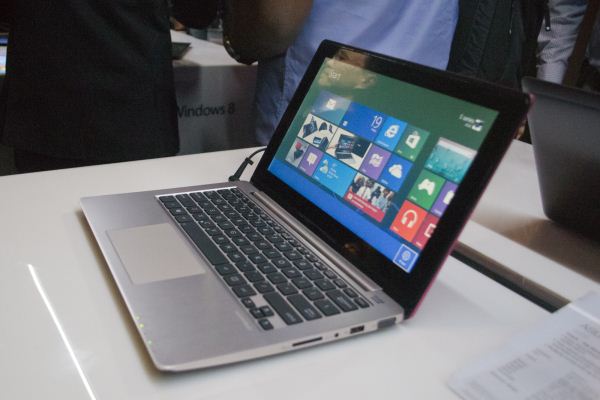
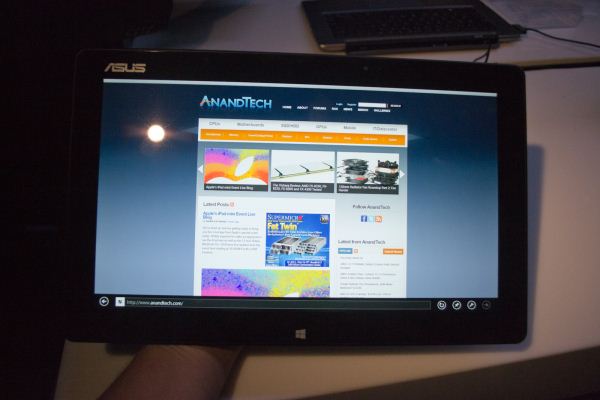

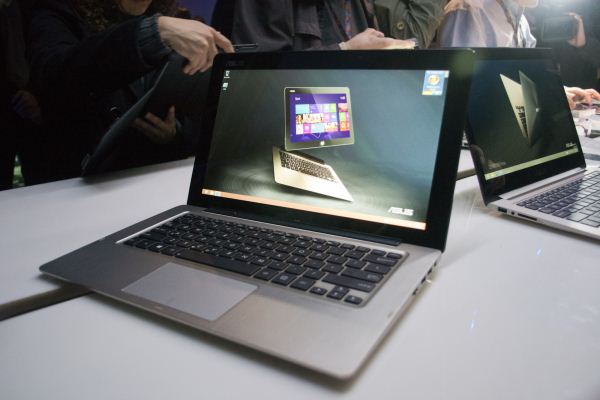
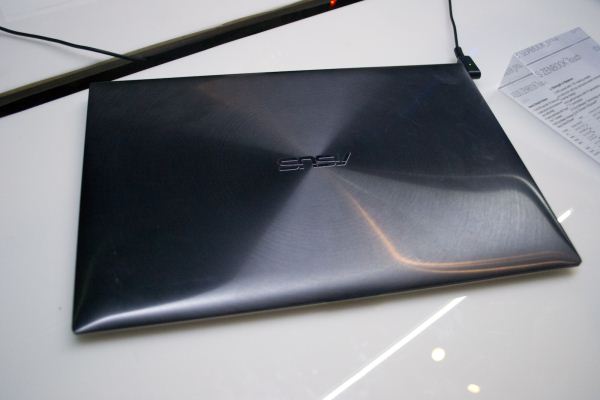


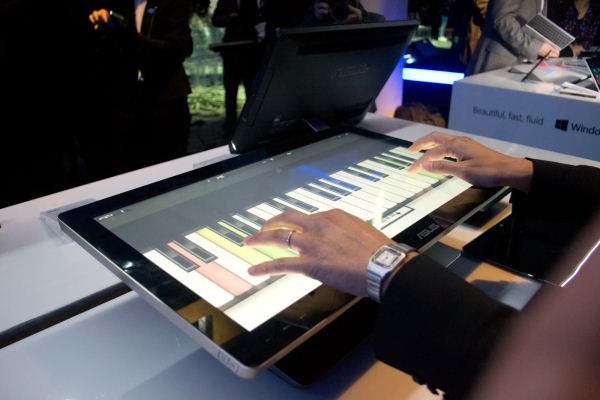








17 Comments
View All Comments
MadMan007 - Tuesday, October 23, 2012 - link
That last pic actually made me LOL thinking that Asus was going to produce a 27" tablet like the one they showed earlier this year! Nice one.CeriseCogburn - Friday, October 26, 2012 - link
At least the screen looks decent with piano keys.Windows 8 is so ugly, so so ugly.
It's so pathetic.
It's so washed out pastel.
It's so retarded.
It's so dumbed down and borked.
It' so ugly, I didn't mention how fugly it is.
What a disaster of idiocy.
db4williams - Tuesday, November 6, 2012 - link
Soooo your saying you don't like it? lolDon't let your nerd rage control you too much. Win8 is'nt that bad.
Zink - Tuesday, October 23, 2012 - link
There's something to be said about the confusion of having so many devices. This is like Windows laptops, even Android tablet lineups are easier to understand.This is only one manufacturer and with another 5 or so big OEMs it gets very confusing for most consumers. I hope there is some attempt to help compare similar products between OEMs and make it easy to understand which is for you. Atom, ARM, i5, 1080p/IPS, battery docks, premium build etc.
Otherwise my Mom would be more likely to go get an iPad because it will be the same as the iPad everyone else has.
dennya - Wednesday, October 24, 2012 - link
Hey, as of today, when you consider color, capacities, and cell providers, there are 51 different iPad models in the US alone!Personally, I'm glad for the variety, because it lets Asus address users with different desires. The 13" Transformer Book looks awesome to me, but I'm sure the 13" tablet seems insane to a lot of people. For those people, there are the 11.6" models.
Simplicity is only a good thing if you have very mainstream desires. If you want something a bit more niche, like the 13" Transformer Book, you appreciate companies like Asus that offer a variety of choices.
MadMan007 - Wednesday, October 24, 2012 - link
It's a point that's been made before, and on a superficial level it makes sense. But when you think about consumer electronics there have always been lots of manufacturers and they've all had wide lineups. Think about audio/video equipment going back decades. Stereos, record players, cassette players, CD players,A/V receivers, televisions - they've all had advances, broad lineups, incompatible technologies, dead ends, and yet people bought them and not just 'whatever everyone else had. Consumers were able to make sense of the lineups somehow.Maybe with computers and now portable devices it's confusing for some consumers - but I would say that goes for older consumers, maybe 40+, who didn't see computing technology evolve until they were a bit older. Young people today are very tech savvy and able to parse the lineups with no more research than people used to do for A/V equipment. There are of course those who are not inclined technically inclined or willing to research but that's what their tech savvy friends are for.
JasonInofuentes - Wednesday, October 24, 2012 - link
I was thinking about this last night and it occurred to me that this is actually a reasonable approach for a company with the design chops and capacity of ASUS. There's a certain mystery behind who will win the balance of performance, form factor and battery life. So putting all your chips on red is way too risky, even Microsoft is hearing this by releasing Surface RT and Surface Pro.Now, in three years, once Windows 8's successor has arrived, if we're still looking at multiple SoC types, multiple form factors, and no clear superior option, then we'll know there's a big problem.
MrSpadge - Wednesday, October 24, 2012 - link
The idea is that your mum wouldn't need to worry wether it's i5 or i7. These are mechanically different designs, so they will actually feel different. Once you decided which one you want, the choice is narrowed down considerably. Best would probably be to try them out in a shop personally.frozentundra123456 - Wednesday, October 24, 2012 - link
Yea, I am totally confused. Dont even know much about the various ARM processers, much less all the tablets available. Not to mention WinRT and what you can do with that. So now you have Android, WinRT, and Win8, not to mention conventional laptops with or without touchscreens, tablets, tablets plus docks, and laptops that fold over like the Levano yoga.Personally, I would probably go with Win8 in some form, even if it is a bit slow (atom) or uses more power (Ivy). My experiences with a Acer A100 and android have been mixed at best. Still seems buggy and really slow, kind of like the old computer I once had running Win ME on a 450mhz celeron with 2mb integrated graphics. The best course might be to wait a year or two for Haswell and maybe something from AMD (???) and let the market sort itself out.
tayb - Thursday, October 25, 2012 - link
Consumer choice is never a problem. Buy what you like. Android gets into trouble because the different options don't have the same version of Android and even with tablets that have uniform versions of Android there are UI customizations that make them look and operate differently.This will be a minor issue with Windows as there will be Windows RT tablets and Windows 8 tablets. The real difference between these being the ability to run x86 apps. So long as Microsoft and retailers/etailers do a good job of educating consumers this shouldn't be a problem. It certainly won't be nearly as big of a problem as it is on Android.